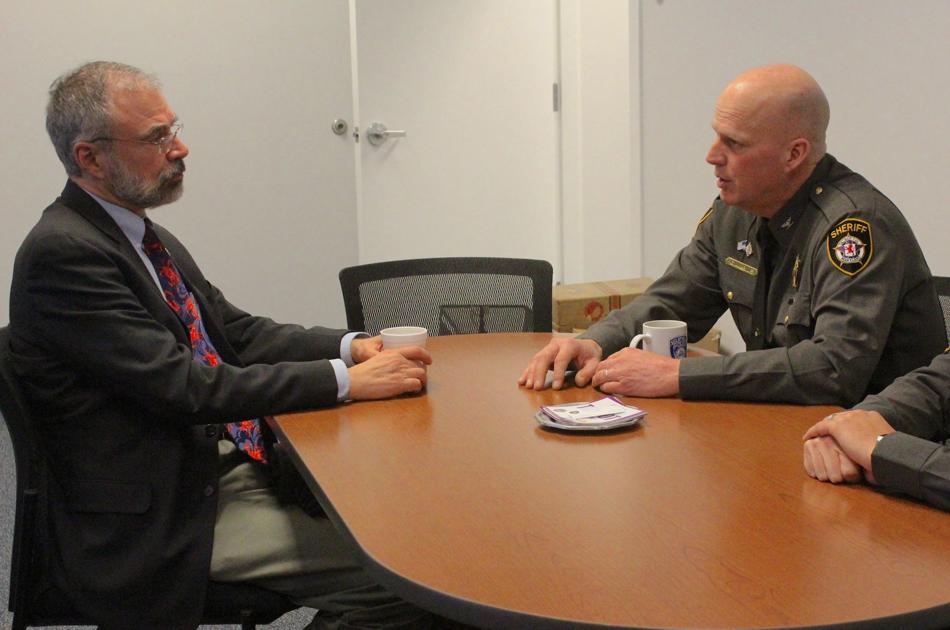
03 Feb Harris visit focuses on opioid addiction | Local
EASTON — U.S. Rep. Andy Harris, R-Md.-1st, met with Talbot County Sheriff Joe Gamble on Friday, Feb. 1, to discuss the opioid epidemic and partnerships between federal and local governments to save lives.
Both Gamble and Harris discussed the impact of Narcan training, the number of overdoses and deaths due to heroin and fentanyl, and “Talbot Goes Purple.” Harris proposed establishing a strong post-treatment program to provide supervision and job placement assistance for recovering addicts.
“We need to plug the holes in the system that we have in terms of making sure that we identify people at risk,” Harris said. “We also need to make sure they get treatment. One hole in the system that exists is post-treatment treatment. Once someone leaves a 30-day program, and they re-enter the community, it’s hit or miss whether they could get to a post-treatment program.”
Gamble said for the past three years, there have been “sober-living situations” in Talbot County and a women’s house that is privately funded.
Gamble said such cases can be dealt with in drug court, with some post-treatment programs made available. He said it is a discipline-rigorous situation where if an individual gets arrested for the third time for possession or with intent, they are cut with a deal and go into a rehab situation.
“If one enters that drug court situation, as a first-time offender, they are put in a rigorous program, and they help those find a job or housing, and then you have to report back to court,” Gamble said. “That is circuit court; they have a social worker, (and) they are not in the (Department of Social Services). They work for the court and monitor these people and track what they are doing, and if they have a job or paying their bills.”
The Talbot County Department of Corrections has a program that gives inmates the opportunity to detox with intense therapy and medication, including Vivitrol and buprenorphine. The jail provides them that medication and then they enter a follow-up program when they leave the jail.
The Maryland Department of Health released data for unintentional drug and alcohol-related intoxication deaths through the second quarter of 2018. During this six-month period, which included January through June of 2018, there were 1,325 total unintentional intoxication deaths, a 12 percent increase over the same period in 2017. Of these, 1,185 were opioid-related deaths in the state, including 1,038 fentanyl-related deaths.
More than three-quarters of all overdose deaths in 2018 involved fentanyl, a trend that has continued since the first quarter of 2017, when the number of fentanyl-related deaths first exceeded the number of heroin-related deaths.
“They realize that this is a spiral,” Harris said. “If you don’t get people out of this cycle of addiction where they not only have addiction, but then people around them are at increased risk of addiction. So I think law enforcement appropriately knows that you have to seize your drugs. You have to unfortunately take people who have problems with addiction and attempt to get into remission to make sure that they stay drug free.”
In Talbot County, Narcan is a great tool, but it’s not the end all, be all of the opioid crisis, Gamble said. However, raising awareness, with projects including Project Purple and “Talbot Goes Purple,” has given the community the opportunity to be a partner through education, volunteering and resources.
So far, the reception of “Talbot Goes Purple” has spread out in different counties in the second year with more counties wanting to participate.
“I worked in every county in the state of Maryland, and this is a very unique community, and we are doing stuff here that people are emulating all over the state,” Gamble said. “Frederick and Anne Arundel County are asking how we did it because they want to start something in their community. The only reason we pulled that off was the community through the church, the business owners and fraternal organizations.”
[ad_2]
Source link



No Comments